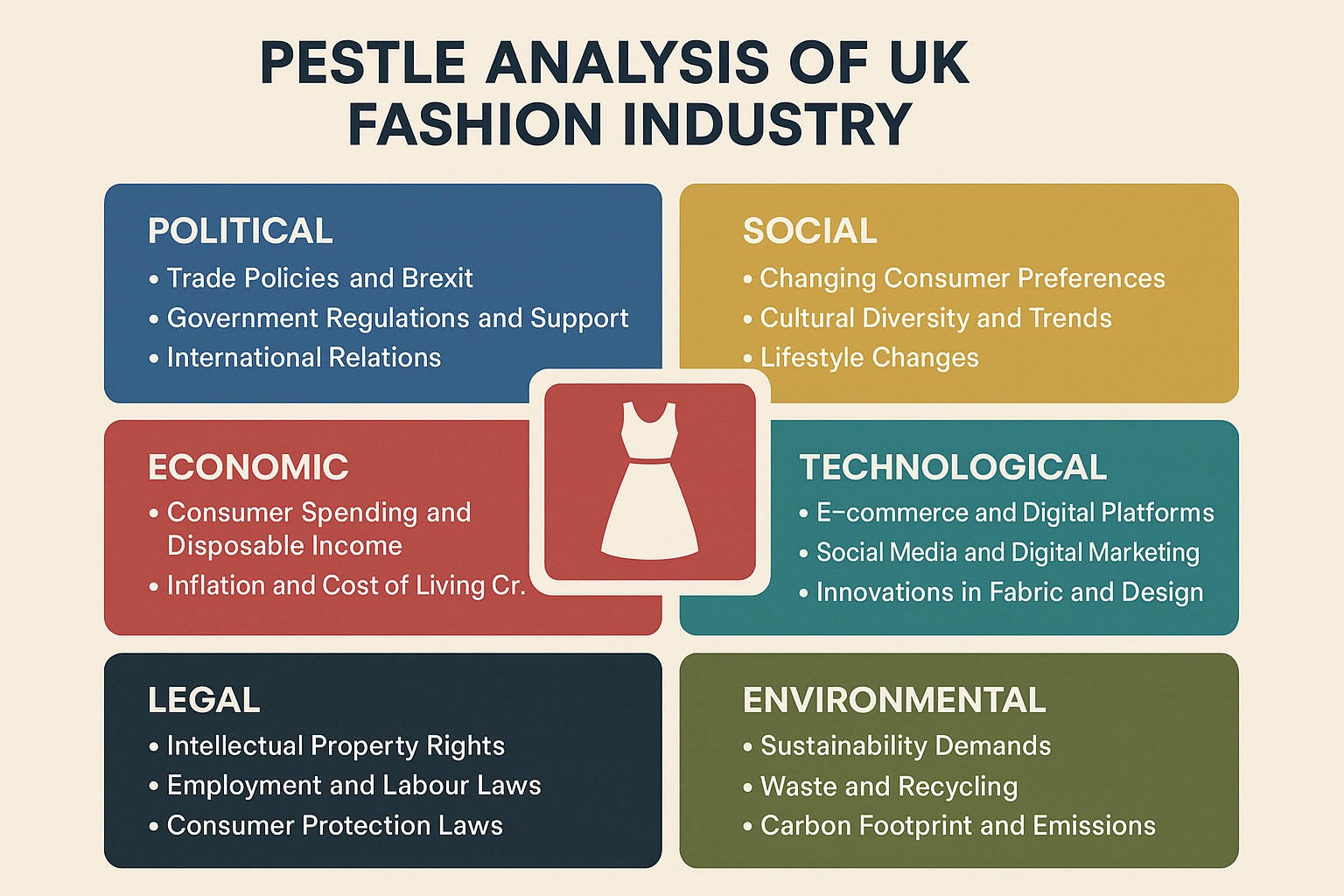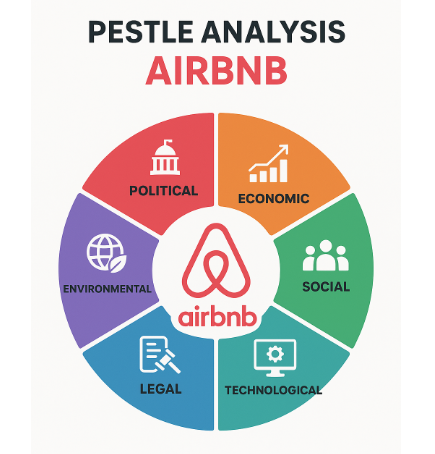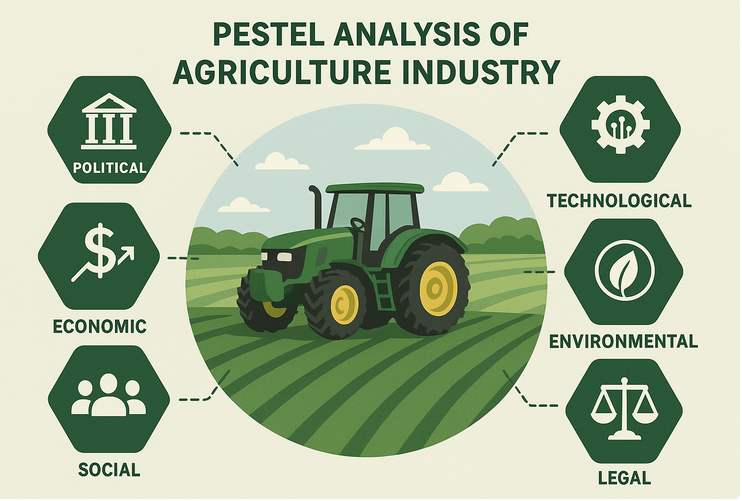The UK fashion industry is a globally recognized and culturally significant sector, known for its creativity, innovation, and economic contribution. However, it operates within a complex macro-environment influenced by various external forces. A PESTLE analysis—covering Political, Economic, Social, Technological, Legal, and Environmental factors—provides a comprehensive overview of the challenges and opportunities shaping the industry. By examining these factors, businesses and stakeholders can better understand market dynamics, anticipate shifts, and make informed strategic decisions in an increasingly competitive and sustainable-focused global landscape.
Table of Contents
TogglePolitical Factors Affecting the UK Fashion Industry:
-
Brexit and Trade Agreements: The UK’s exit from the European Union has introduced new customs regulations, tariffs, and trade barriers. These changes have affected the import and export of textiles and garments, creating supply chain disruptions and increased costs for many fashion businesses.
-
Government Support and Regulation: UK government policies, such as support for small businesses, innovation funding, and sustainability incentives, play a key role in shaping the fashion sector’s growth. Regulations around working conditions and tax policies also impact business operations.
-
Global Political Relations: The UK’s diplomatic relationships with major textile-producing countries like China, India, and Bangladesh affect trade terms and the reliability of global sourcing for fashion retailers and manufacturers.
-
Post-Brexit Immigration Policy: Stricter immigration rules affect the availability of skilled and unskilled labor in the fashion industry, particularly in manufacturing, warehousing, and retail sectors.
-
Regulations on Ethical Practices: Increasing political pressure to ensure ethical labor standards and supply chain transparency is pushing fashion companies to improve practices and avoid reputational or legal risks.
Economic Factors Affecting the UK Fashion Industry:
-
Inflation and Cost of Living: The rising cost of living and inflation in the UK have reduced consumers’ disposable income, leading to decreased spending on non-essential items like fashion. This shift forces brands to adjust pricing strategies and offer more affordable options.
-
Consumer Spending Patterns: Economic fluctuations directly influence buying behavior. In times of economic growth, demand for luxury and high-end fashion increases, while during downturns, consumers prioritize budget-friendly and second-hand clothing.
-
Exchange Rates and Import Costs: The fashion industry relies heavily on imported materials and finished goods. Fluctuations in the British pound impact import costs, affecting profit margins and retail prices.
-
Employment Rates and Wages: High employment levels and wage growth support consumer confidence and spending. However, wage pressures also increase operational costs for retailers and manufacturers.
-
Growth of E-commerce and Digital Economy: The increasing importance of online shopping has created new economic opportunities for fashion brands, enabling them to reach wider markets, reduce physical store costs, and benefit from global sales.
Social Factors Affecting the UK Fashion Industry:
-
Sustainability and Ethical Awareness: UK consumers are becoming more conscious of environmental and ethical issues. There is growing demand for sustainable fashion, ethical sourcing, and transparency in production processes.
-
Changing Fashion Trends: Social media, influencers, and fast-changing consumer tastes drive short-lived fashion trends. Brands must respond quickly to stay relevant and competitive in the market.
-
Diversity and Inclusion: There is increasing emphasis on diversity in fashion, including inclusive sizing, representation of different ethnicities and body types, and gender-neutral collections. Brands that reflect these values tend to gain consumer loyalty.
-
Lifestyle Changes: Post-pandemic shifts such as remote working have altered clothing preferences. Casual, comfortable, and versatile styles are now more popular than traditional workwear or formal fashion.
-
Youth Influence and Social Media: Younger generations, especially Gen Z, have a powerful influence on fashion trends through platforms like TikTok and Instagram. Their values—centered on authenticity, sustainability, and individuality—are reshaping the industry.
Technological Factors Affecting the UK Fashion Industry:
-
Growth of E-commerce Platforms: Technology has revolutionized how consumers shop, with online retail becoming a dominant force in the UK fashion market. Brands are investing in seamless digital experiences, mobile apps, and secure payment systems to meet customer expectations.
-
Social Media and Influencer Marketing: Platforms like Instagram, TikTok, and YouTube play a critical role in trendsetting and brand promotion. Fashion companies use these tools for targeted advertising, influencer collaborations, and real-time customer engagement.
-
AI and Data Analytics: Artificial Intelligence is helping fashion brands predict trends, manage inventory, and personalize shopping experiences. Data analytics provides insights into consumer behavior, allowing for smarter decision-making and product development.
-
Virtual Try-Ons and Augmented Reality (AR): Innovative technologies like AR allow customers to visualize how clothes will look on them before purchasing, improving customer satisfaction and reducing returns.
-
Sustainable Technology and Smart Fabrics: Technological advancements are enabling the production of eco-friendly textiles, biodegradable fabrics, and smart clothing with embedded sensors—enhancing product innovation while supporting sustainability goals.
Legal Factors Affecting the UK Fashion Industry:
-
Intellectual Property (IP) Protection: Fashion brands rely heavily on copyright, trademarks, and design rights to protect their creative works. UK law offers legal support against counterfeiting and design theft, which is essential in maintaining brand integrity.
-
Employment and Labour Laws: The industry must comply with national employment regulations regarding fair wages, working hours, health and safety, and employee rights. This applies to both local workers and those involved in global supply chains.
-
Consumer Protection Laws: Fashion companies are required to follow strict rules on product quality, labeling, advertising standards, and return/refund policies. Misleading promotions or defective products can lead to legal penalties.
-
Environmental Compliance: Legal obligations related to waste management, chemical usage, and emissions are increasing. Fashion businesses must adhere to UK and international environmental laws, particularly those targeting fast fashion’s environmental impact.
-
Post-Brexit Trade Regulations: Since leaving the EU, UK fashion brands face new customs laws, VAT changes, and export/import duties. Navigating this new legal landscape is essential to avoid delays, added costs, and compliance issues.
Environmental Factors Affecting the UK Fashion Industry:
-
Sustainability Expectations: There is growing pressure from consumers and regulators for fashion brands to adopt sustainable practices. This includes reducing environmental impact through eco-friendly materials, ethical sourcing, and responsible manufacturing.
-
Textile Waste and Fast Fashion: The UK generates a significant amount of clothing waste due to fast fashion trends. Consumers and environmental groups are demanding circular fashion models that emphasize recycling, upcycling, and longer product lifespans.
-
Carbon Emissions and Climate Impact: Fashion production and global supply chains contribute to greenhouse gas emissions. Brands are being encouraged to reduce their carbon footprints through green logistics, energy-efficient practices, and local sourcing.
-
Water and Chemical Usage: Traditional textile manufacturing consumes large amounts of water and harmful chemicals, leading to pollution. The industry is under pressure to adopt cleaner, water-saving technologies and safer dyeing methods.
-
Government Regulations and Green Policies: Environmental regulations in the UK, such as climate targets and waste reduction laws, are pushing fashion companies to rethink their operations and align with national and global sustainability goals.
Conclusion
The UK fashion industry is shaped by a wide range of external influences, as highlighted through the PESTLE framework. Political changes like Brexit, economic challenges such as inflation, and evolving social values toward sustainability and inclusivity all have a significant impact. Technological innovations are transforming how fashion is designed, marketed, and sold, while legal and environmental pressures are pushing brands to operate more ethically and responsibly. Understanding these factors enables businesses to adapt strategically, stay competitive, and build resilience in an industry that is as fast-paced as it is globally significant.





Leave a Reply